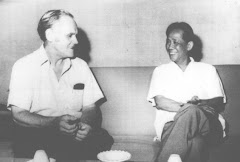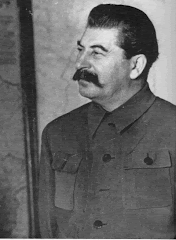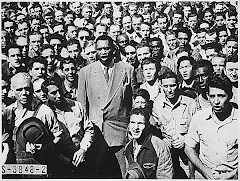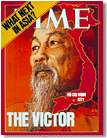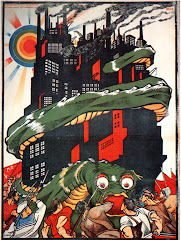"U.S. Income Inequality Is Growing. And It’s Not a Temporary Blip"
Comment:
What an observation!
Question:
What does the AFL-CIO leadership offer as a solution?
Answer:
Elect more "Republican Lite" Democrats like Hillary Clinton or Barak Obama or Amy Klobuchar or Nancy Pelosi.
Comment:
At least the word "socialism" is mentioned in this article; however, there is no suggestion that capitalism is the source of the problem or that we need a socialist solution. Once again we are faced with the same old crap of electing the same old do-nothing, acquiescent Democrats who don't even have the courage (or the inclination) to stand up and say they will put an end to this dirty war in Iraq... much less challenge the economic order.
Understanding there is a a "class" divide in this country and a continuing "class struggle" would contribute to a better understanding of this problem.
The leaders of the AFL-CIO would be better off studying Karl Marx than taking their advice from these "think tanks."
Working people need real "think and do tanks" of the Marxist variety. During the 1930's and 1940's working people in this country had such "think and do tanks" in workplaces across this country... they were called Communist Party Clubs... something to think about.
This article concludes:
Understanding that the widening income gap in this nation is not a passing phase is the first step. Electing those to office in 2007 and 2008 who also understand this is the next.
I think most of us understand that the rich get richer because the poor get poorer.
What I don't see is many candidates coming down the pike who understand "why" this is happening. Worse yet I don't see many candidates coming down the pike willing to challenge this. If we got back to a labor movement with a leadership which appreciates rank and file activism along with the creation of "think and do tanks" in the workplaces across America we could be fielding a slate of candidates to challenge all of this.
Instead of encouraging militant rank and file activism the current leadership at the helm of the AFL-CIO and Change to Win is mired in a fairy tale world thinking that in some way their non-class struggle approach towards corporate power and capitalist globalization which has led to defeat after defeat in contract negotiations will somehow be remedied by a similar non-class struggle approach in the electoral arena. It ain't going to happen.
It takes a united, militant working class struggle approach to win at the bargaining table; and, it takes an even broader, more united and more militant working class struggle to win in the electoral arena what you can't win at the bargaining table.
Link:
http://blog.aflcio.org/2007/10/12/us-income-inequality-is-growing-and-its-not-a-temporary-blip/
U.S. Income Inequality Is Growing. And It’s Not a Temporary Blip
by Tula Connell, Oct 12, 2007
Jim Lardner, a senior fellow at the progressive think tank Demos, offers the following four “curious features” of American life—observations confirmed by findings revealed in today’s Wall Street Journal:
In his middle-class Manhattan neighborhood, The New York Times has taken to delivering a glossy, 100+ page supplement filled with advertisements for $16 million homes and similar out-of-this world real estate.
The top floors of many hospitals now offer suites for patient care, with attendants in neat “bellmen”-like uniforms, attending to every need.
Formerly free after-school activities, such as taking part in the school play, now cost parents hundreds of dollars.
Skyrocketing college tuition has soared so exponentially, retirees and even residents of nursing homes still are paying off their college loans.

Lardner, co-author of Inequality.org, an online research center for journalists, teachers and concerned citizens, spoke last week here in Washington, D.C., as part of a panel on the nation’s economy during the Green Festival.
In adding hard data to Lardner’s impressionistic observations, The Wall Street Journal reports that “the richest Americans’ share of national income has hit a postwar record, surpassing the highs reached in the 1990s bull market, and underlining the divergence of economic fortunes blamed for fueling anxiety among American workers.”
The wealthiest 1 percent of Americans earned 21.2 percent of all income in 2005, according to new data from the Internal Revenue Service. That is up sharply from 19 percent in 2004, and surpasses the previous high of 20.8 percent set in 2000, at the peak of the previous bull market in stocks.
The Journal’s conclusion, based on an analysis of tax data from the Internal Revenue Service (IRS), is the latest in a growing body of information pointing to the widening gap between the Two Americas and an increasing public awareness that something more than a cyclical economic “adjustment” is wrong with this nation’s economy. Earlier this week, the Center for Economic and Policy Research (CEPR), which sponsored the panel, issued a report with the Center for Social Policy that finds low wages, inadequate benefits, and limited work supports leave one-in-five people (nearly 41 million) in working families struggling to make ends meet.
“Bridging the Gaps: A Picture of How Work Supports Work in Ten States” confirms what the union movement has been asserting for some time: Many workers are in jobs that do not provide health insurance or enough earnings to cover basic expenditures. At the same time, these workers earn too much to qualify for work supports such as Medicaid and Food Stamps. (The Economic Policy Institute held a panel discussion last week on how work supports, properly funded and run, can bridge the gap for the working poor. More here.)
In fact, since 1973 the incomes of the top 0.1 percent—families earning $1.3 million a year—increased 353 percent. More than half of all economic growth since 1979 has gone to the richest 10 percent of America’s families, most of it to the top 1 percent. This data is part of the AFL-CIO’s “An Economy That Works for All” campaign, in which we are holding trainings with union members across the nation where it becomes clear that while we once grew together as a nation, today we are growing apart—economically, socially and politically. The goal of these trainings is to mobilize activists to take action and reverse this slide into Rich-Poor nationhood.
CEPR Economist Heather Boushey, co-author of the study, also spoke at the panel here last week, where she offered even more confirmation of the Two Americas. Boushey notes the corporate tax burden of top earners has declined by two-thirds since 1962, even as most of us are working an average 13.3 weeks more per year compared with the previous generation. Yet, as the CEPR study shows, these longer hours aren’t benefiting millions of working people.
Boushey also points out why most of us feel a disconnect between claims that we are living in a sound economy and our own paycheck-to-paycheck reality. When mainstream media describes the economy, two contradictory points are made: How rich we are as a nation and how we as a nation are unable to afford a robust safety net.
Reconciling these two themes, says Boushey, is the fact that the nation’s growing economic benefits have been funneled to a small group of the already wealthy, depleting the nation’s tax base and effectively defunding programs such as those that would make a difference for the working poor. When we hear the government can’t “afford” such programs, Boushey says, what that translates to is:
Let the wealthy take a bigger piece of the pie while telling the rest of us that’s the way it is.
Some Republicans in Congress scream “socialism” when fighting to prevent passage of children’s health insurance, but when it comes to tax cut handouts, they not only are first in line, they ensure Bush’s tax cuts for the wealthy pass every time. Not only are Bush’s tax breaks (passed multiple times since 2001) heavily skewed toward the very wealthiest few, according to Citizens for Tax Justice:
Because the tax cuts are being paid for with borrowed money, the cost of paying the added national debt more than wipes out any benefits from the tax cuts for 99 percent of residents in each state. Only the best-off one percent are net winners from the president’s fiscal policies.
The struggles we’re facing aren’t a temporary blip in the economic cycle. Since 1973, the growth of family incomes has been much slower, even as the incomes of the richest 20 percent of families have risen much faster. As the percentage of workers in unions declined during this period, their power and the ability to protect their living standards also diminished.
As Jason Furman, a scholar at the Brookings Institution and an adviser to Democratic politicians, said in today’s Wall Street Journal:
We’ve had a 30-year trend of increasing inequality. There was an artificial reduction in that trend following the bursting of the stock-market bubble in 2000.
Understanding that the widening income gap in this nation is not a passing phase is the first step. Electing those to office in 2007 and 2008 who also understand this is the next.






